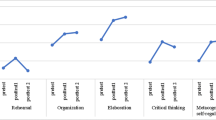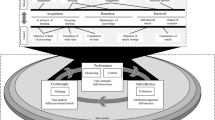Abstract
This study investigated the self-regulatory behaviors of arts students, namely memory strategy, goal-setting, self-evaluation, seeking assistance, environmental structuring, learning responsibility, and planning and organizing. We also explored approaches to learning, including deep approach (DA) and surface approach (SA), in a comparison between students’ professional training and English learning. The participants consisted of 344 arts majors. The Academic Self-Regulation Questionnaire and the Revised Learning Process Questionnaire were adopted to examine students’ self-regulatory behaviors and their approaches to learning. The results show that a positive and significant correlation was found in students’ self-regulatory behaviors between professional training and English learning. The results indicated that increases in using self-regulatory behaviors in professional training were associated with increases in applying self-regulatory behaviors in learning English. Seeking assistance, self-evaluation, and planning and organizing were significant predictors for learning English. In addition, arts students used the deep approach more often than the surface approach in both their professional training and English learning. A positive correlation was found in DA, whereas a negative correlation was shown in SA between students’ self-regulatory behaviors and their approaches to learning. Students with high self-regulation adopted a deep approach, and they applied the surface approach less in professional training and English learning. In addition, a SEM model confirmed that DA had a positive influence; however, SA had a negative influence on self-regulatory behaviors.


Similar content being viewed by others
References
Anderson, J. C., & Gerbing, D. W. (1988). Structural equation modeling in practice: A review and recommended two-step approach. Psychological Bulletin, 103(3), 411.
Baeten, M., Kyndt, E., Struyven, K., & Dochy, F. (2010). Using student-centered learning environments to stimulate deep approaches to learning: Factors encouraging or discouraging their effectiveness. Educational Research Review, 5, 243–260.
Bandura, A. (1986). Social foundations of thought and action: A social cognitive theory. Englewood Cliffs, NJ: Prentice Hall.
Bandura, A. (2002). Social cognitive theory: An agentic perspective. Annual Review of Psychology, 51(2), 269–290.
Baum, S., Owen, S., & Oreck, B. (1997). Transferring individual self-regulation processes from arts to academics. Arts Education Policy Review, 98(4), 32–39.
Baumeister, R. F., & Vohs, K. D. (2007). Self-regulation, ego depletion, and motivation. Social and Personality Psychology Compass, 1(1), 115–128.
Baumgart, N., & Halse, C. (1999). Approaches to learning across cultures: The role of assessment. Assessment in Education, 6(3), 321–330.
Biggs, J. B. (1987a). Student approaches to learning and studying. Camberweel, Vic.: Australian Council for Educational Research.
Biggs, J. B. (1987b). The study process questionnaire: Manual. Hawthorn, Vic.: Australian Council for Educational Research.
Buehl, M. M., & Alexander, A. P. (2005). Motivational and performance differences in students’ domain-specific epistemological belief profiles. American Educational Research Journal, 42(4), 697–726.
Byrne, B. M. (2013). Structural equation modeling with AMOS: Basic concepts, applications, and programming. Boca Raton, FL: CRC Press.
Fornell, C., & Larcker, D. F. (1981). Evaluating structural equation models with unobservable variables and measurement error. Journal of Marketing Research, 18, 39–50.
Gow, L., Kember, D., & Chow, R. (1991). The effects of English language ability on approaches to learning. RELC Journal, 22(1), 49–68.
Hair, J. F., Black, W. C., Babin, B. J., & Anderson, R. E. (2010). Multivariate data analysis (7th ed.). Upper Saddle River, NJ: Prentice Hall.
Hayes, F., Hayes, L., & Hayes, J. (1981). A cognitive process theory of writing. College Composition and Communication, 32, 365–387.
Heikkilä, A., & Lonka, K. (2006). Studying in higher education: students’ approaches to learning, self? Regulation, and cognitive strategies. Studies in Higher Education, 31(1), 99–117.
Hu, L., & Bentler, P. M. (1999). Cutoff criteria for fit indexes in covariance structure analysis: Conventional criteria versus new alternatives. Structural Equation Modeling, 6, 1–55.
Kellogg, R., & Raulerson, B. (2007). Improving the writing skills of college students. Psychometric Bulletin and Review, 14, 237–242.
Kember, D., Biggs, J., & Leung, D. Y. P. (2004). Examining the multidimensionality of approaches to learning through the development of a revised version of the learning process questionnaire. Educational Psychology Journal, 74, 261–279.
Kim, K. H. (2005). The relation among fit indexes, power, and sample size in structural equation modeling. Structural Equation Modeling, 12(3), 368–390.
Magno, C. (2009). Self-regulation and approaches to learning in English composition writing. TESOL Journal, 1, 1–16.
Marton, F., & Saljo, R. (1976). On qualitative differences in learning: II-Outcome as a function of the learner’s conception of the task. British Journal of Educational Psychology, 46, 115–127.
McClelland, M. M., Connor, M. C., Jewkes, M. A., Cameron, E. C., Farris, L. C., & Morrison, J. F. (2007). Links between behavioral regulation and preschooler’s literacy, vocabulary, and math skills. Developmental Psychology, 43(4), 947–959.
Miller, J. W. (2000). Exploring the source of self-regulated learning: The influence of internal and external comparison. Journal Instructional Psychology, 27(1), 47.
Pintrich, R. P., & De Groot, V. E. (1990). Motivational and self-regulated learning components of classroom academic performance. Journal of Educational Psychology, 82(1), 33–40.
Stodolsky, S., & Grossman, P. (1995). The impact of subject matter on curricular activity: An analysis of five academic subjects. American Educational Research Journal, 32, 227–249.
Tucker, L. R., & Lewis, C. (1973). A reliability coefficient for maximum likelihood factor analysis. Psychometrika, 38(1), 1–10.
Winner, E., & Cooper, M. (2000). Mute those claims: No evidence yet for a causal link between arts study and academic achievement. Journal of Aesthetic Education, 34(3/4), Special Issue:The arts and academic achievement: What the evidence shows, 11–75.
Wolters, A. C., & Pintrich, R. P. (1998). Contextual differences in student motivation and self-regulated learning in mathematics, English, and social studies classrooms. Instructional Science, 26, 27–47.
Woolfolk, A. E. (2005). Educational Psychology (11th ed.), Allyn and Bacon.
Zimmerman, B. J., & Martinez-Pons, M. (1986). Development of a structured interview for assessing student use of self-regulated learning strategies. American Educational Research Journal, 23, 614–628.
Zimmerman, B. L., & Martinez-Pons, M. (1988). Construct validation of a strategy model of student self regulated learning. Journal of Educational Psychology, 80, 284–290.
Author information
Authors and Affiliations
Corresponding author
Ethics declarations
Conflict of interest
The authors declare that they have no conflict of interest.
Rights and permissions
About this article
Cite this article
Tseng, Mc., Chen, Cc. Self-regulatory Behaviors and Approaches to Learning of Arts Students: A Comparison Between Professional Training and English Learning. J Psycholinguist Res 46, 643–659 (2017). https://doi.org/10.1007/s10936-016-9460-0
Published:
Issue Date:
DOI: https://doi.org/10.1007/s10936-016-9460-0




